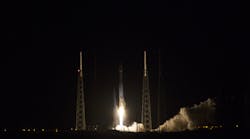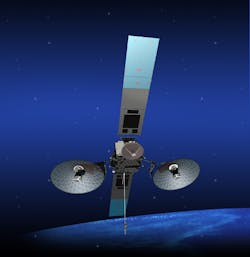NASA’s Tracking and Data Relay Satellite (TDRS) Project began operation with the launch of TDRS-1 in 1983. Impressively, eight of the 11 spacecraft launched to support the space communications network are still operational. Last month, the 12th satellite, TDRS-L, was successfully launched into orbit aboard a United Launch Alliance Atlas V rocket from the Cape Canaveral Air Force Station in Florida.
A three-month health checkout is currently being performed by the satellite’s manufacturer, Boeing Space and Intelligent Systems. Once the satellite passes those tests, NASA will complete additional testing and put the TDRS-L into service. Compared to previous-generation satellites, which use on-orbit beamforming of S-band multiple-access return services, the latest TDRS satellites utilize ground-based beamforming (GBBF). This approach takes the location for communications signal processing of service changes from the spacecraft to the ground, providing more flexibility and unique tailoring options (see “TDRS Communications Satellite Uses Ground-Based Beamforming” on Microwaves & RF).
The TDRS fleet will support the first test of NASA’s latest deep-space spacecraft, the Orion crew module. The Orion will travel farther in space than any system has in more than 40 years. The TDRS-L is identical to the TDRS-K spacecraft launched in 2013. The next spacecraft in the series, the TDRS-M, is on track to be launched in late 2015.

